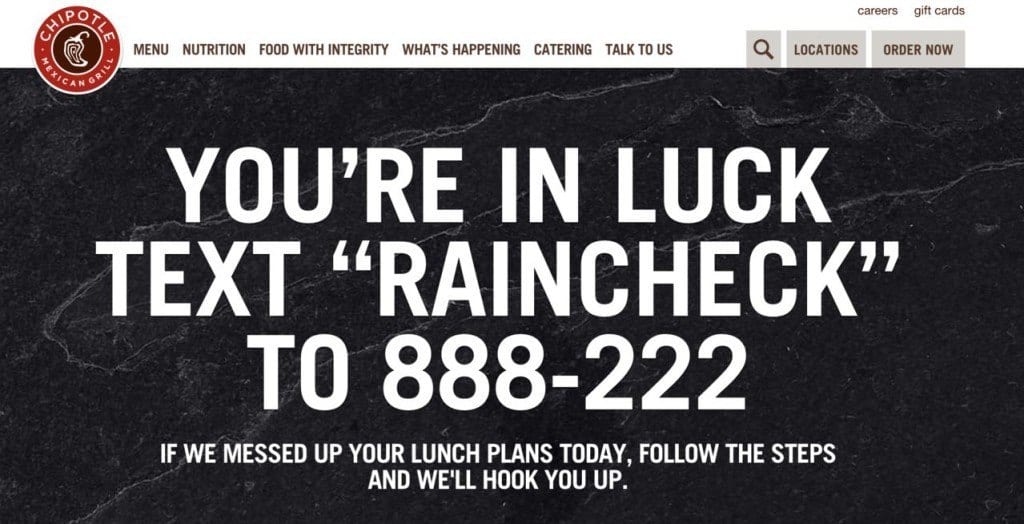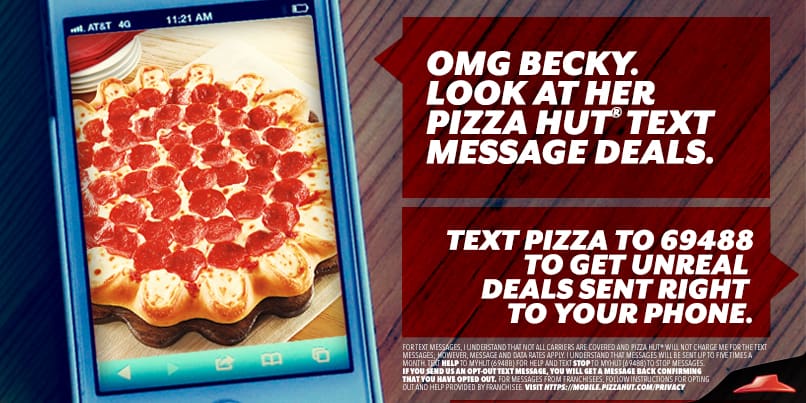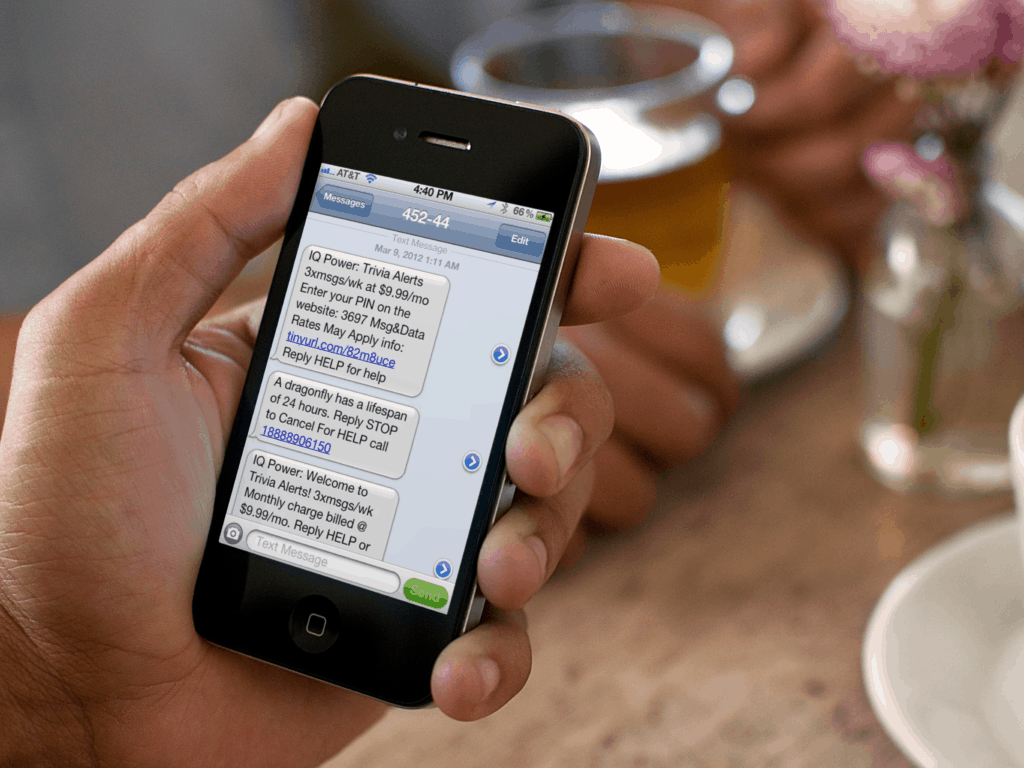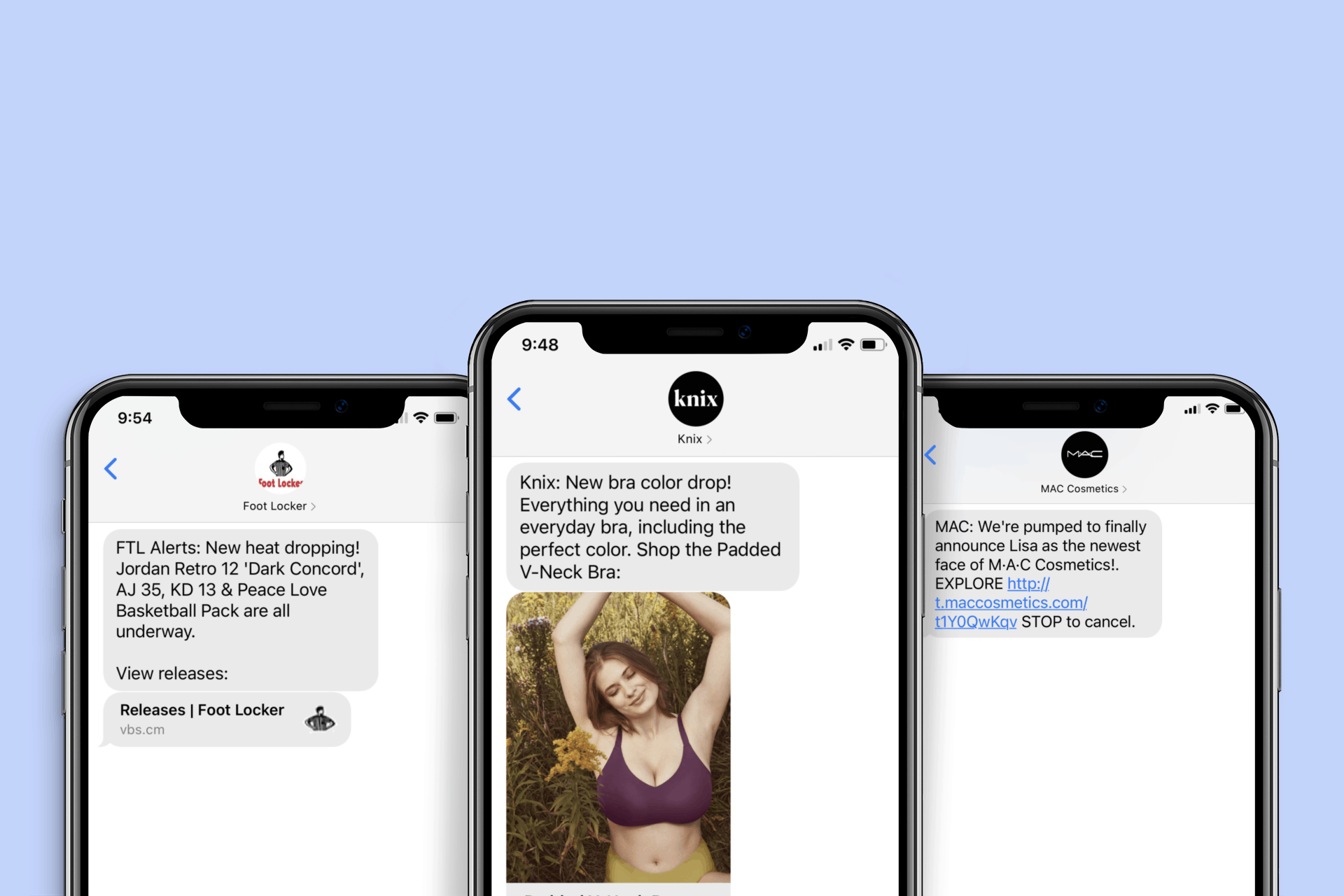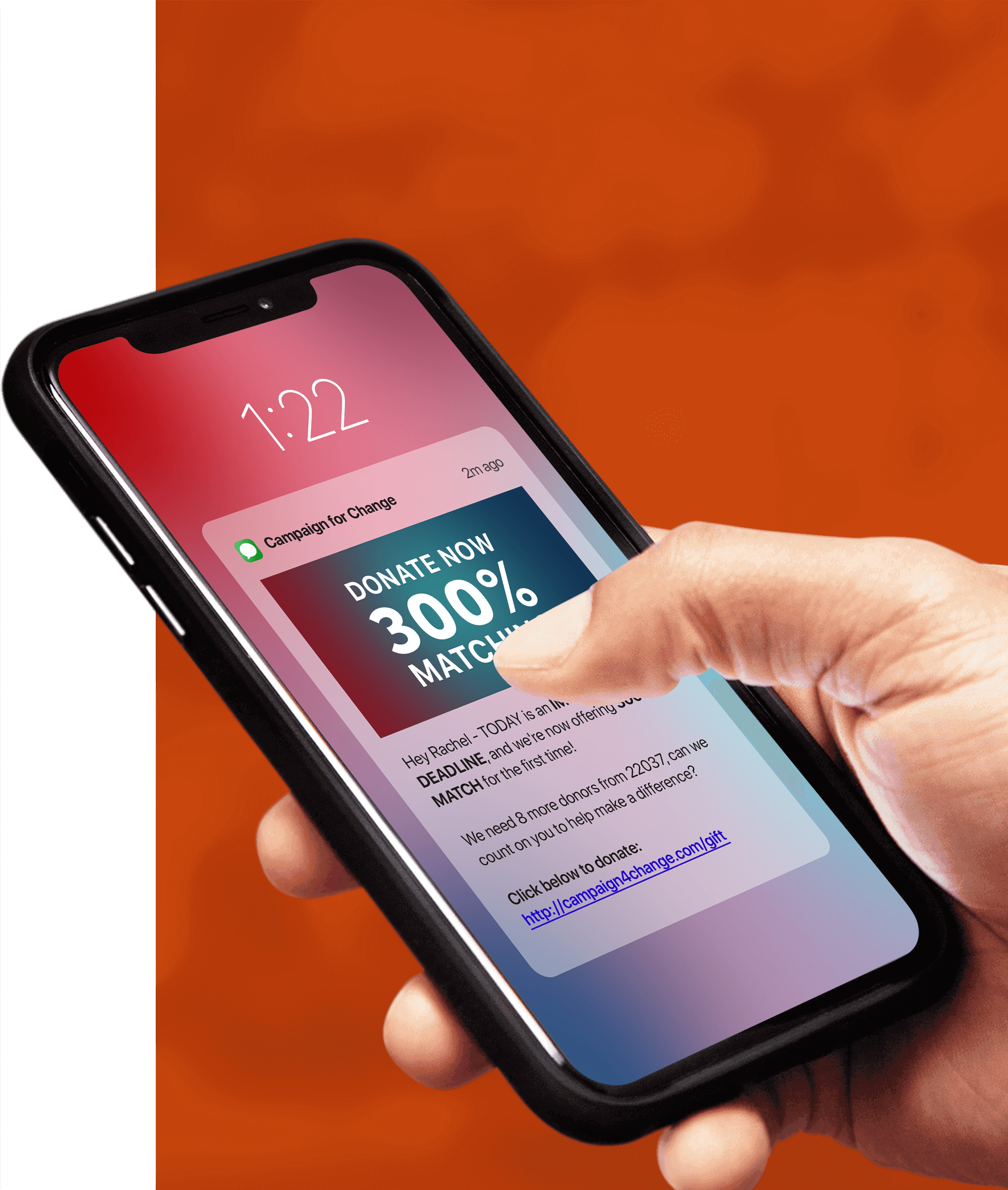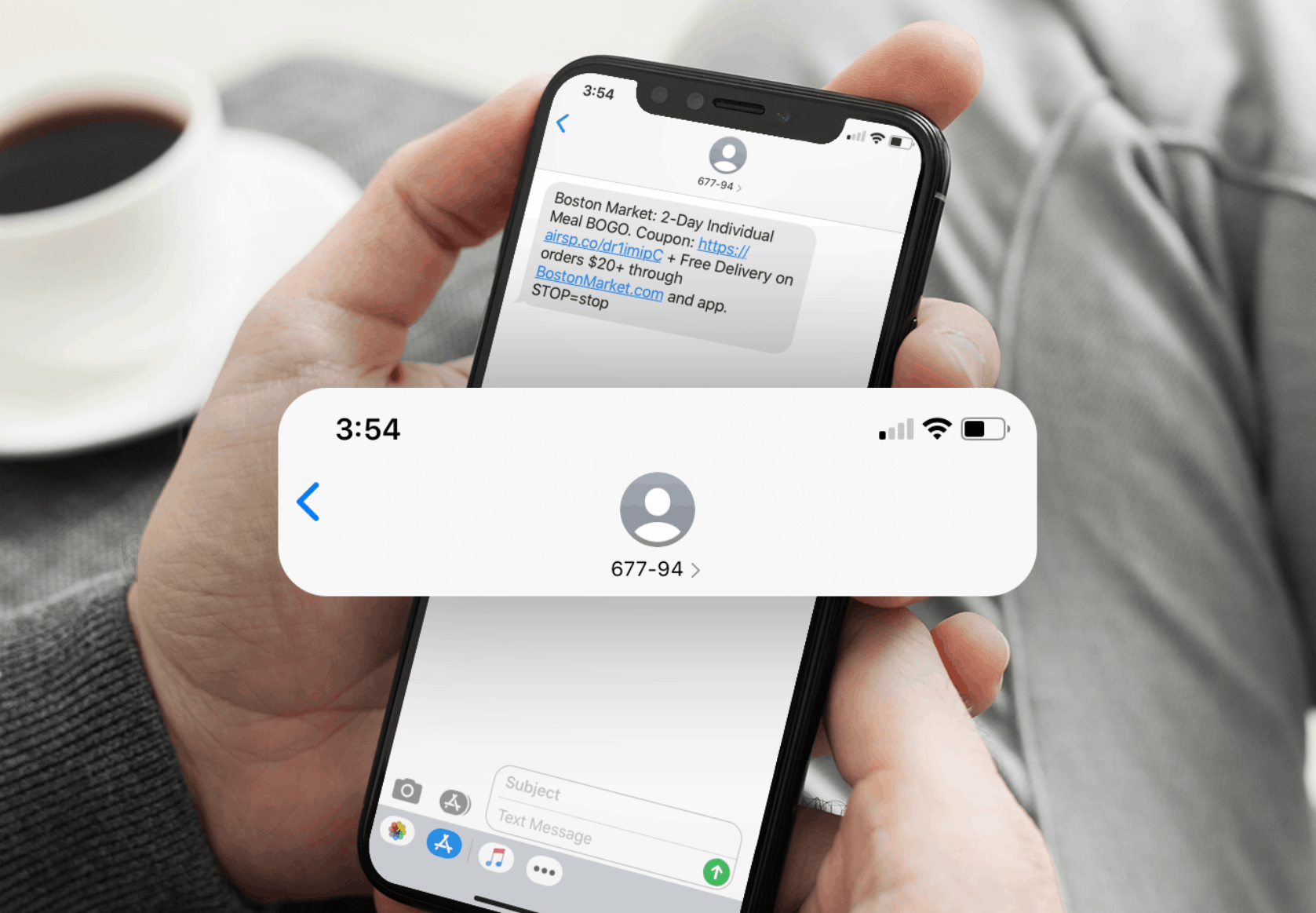
SMS Marketing is one of the most valuable ways to increase sales for your business. Becoming an effective SMS marketer means the difference between increased sales and stagnant progress in your business. Learning key components within SMS marketing—and effectively using them—can make all the difference. To get you started, Tatango has put together a post with everything you need to know about SMS short code texting.
What is a SMS Short Code?
An SMS short code is a 5- to 6-digit phone number used by brands to run their text message marketing campaigns. Consumers can opt into these campaigns by texting a keyword to a company’s short code. Businesses then send automated text messages to these opted-in subscribers. The messages typically contain coupons, offers, company communications, and promotions.
For a consumer to interact with an SMS short code, the consumer needs to compose a new text message on their cell phone and address it to a brand’s SMS short code. Watch the video to learn more.
SMS Marketing
SMS marketing is the broad term for a combination of commercial SMS text messaging and short code text messaging practices. When brands talk about SMS marketing, most refer to the practice of sending mass text messages to consumers’ mobile devices. You can compare SMS marketing with email marketing; instead of emails, a brand sends out text alerts to consumers who have opted into its mobile marketing campaign.
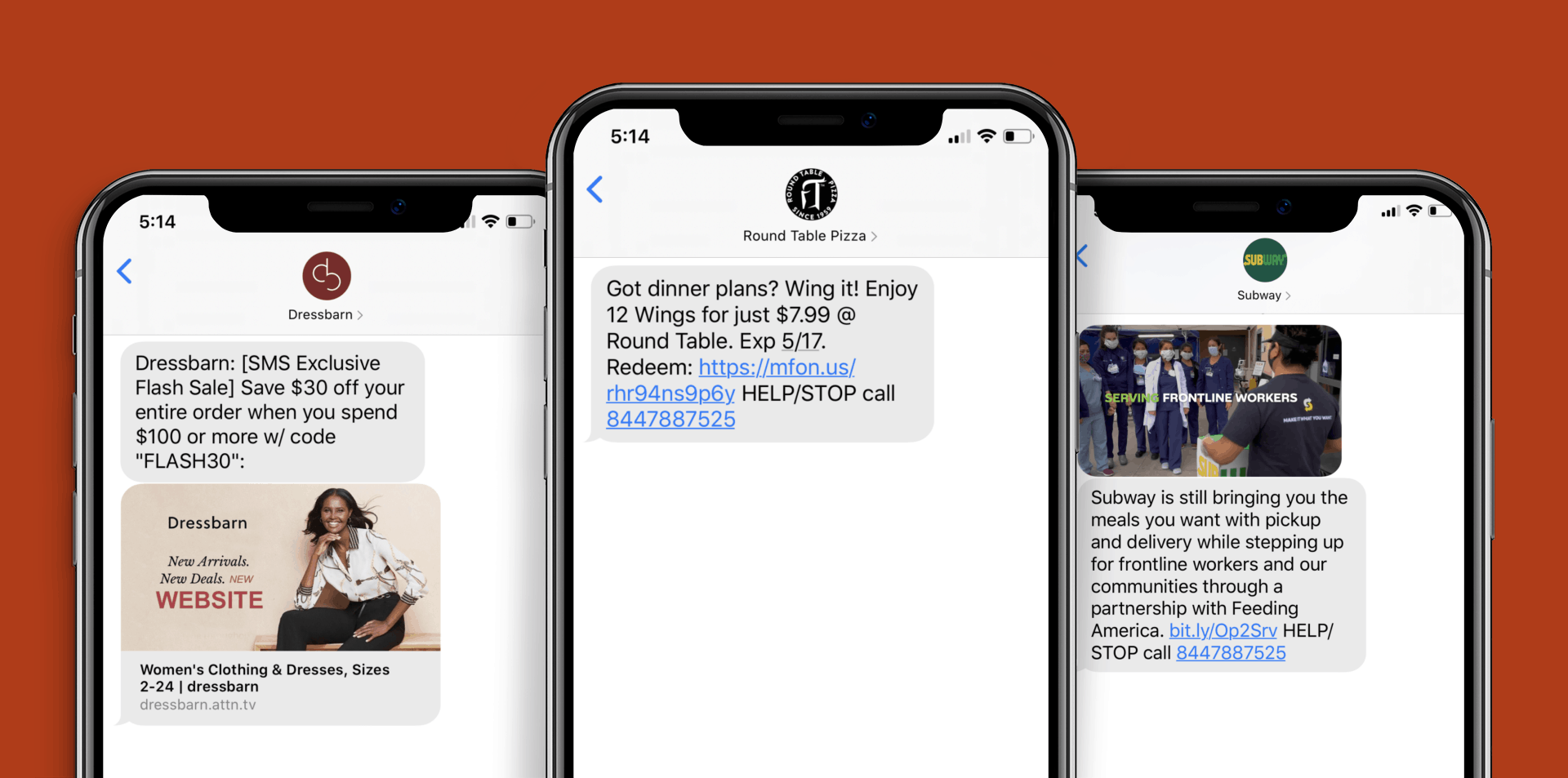
Text message marketing is strictly a permission-based form of marketing. This means you can’t send messages to people who haven’t opted into your text campaign. Consumers first need to go through an opt-in process that confirms their consent to receive messages. This opt-in process starts when someone texts an SMS keyword like “PIZZA” to the brand’s SMS shortcode phone number, such as 12345.
Types of Text Messages and Examples
In SMS marketing, there are two main types of text messages: SMS and MMS. If you haven’t heard about SMS Archives, check it out! It’s a powerful resource for text message marketers. You can even filter your search by message type and more.
SMS Message
Short Message Service (SMS) messages consist of text, weblinks, and promo codes with a 160-character limit. Check out some examples below.
Use SMS to Promote Deals
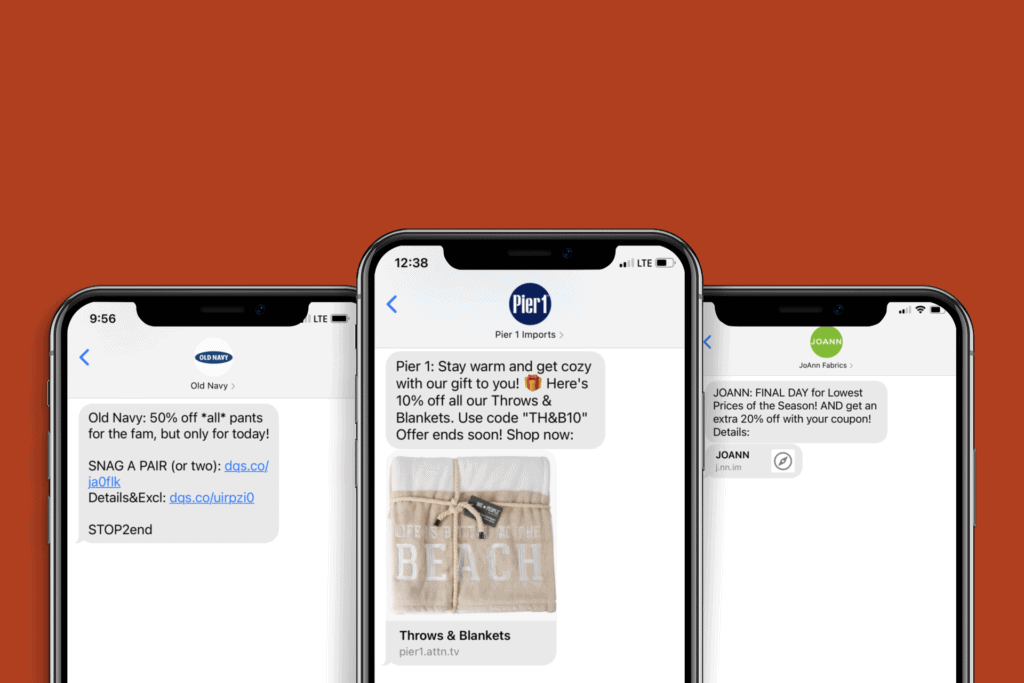
Use SMS to Incentivize Dollar Spend
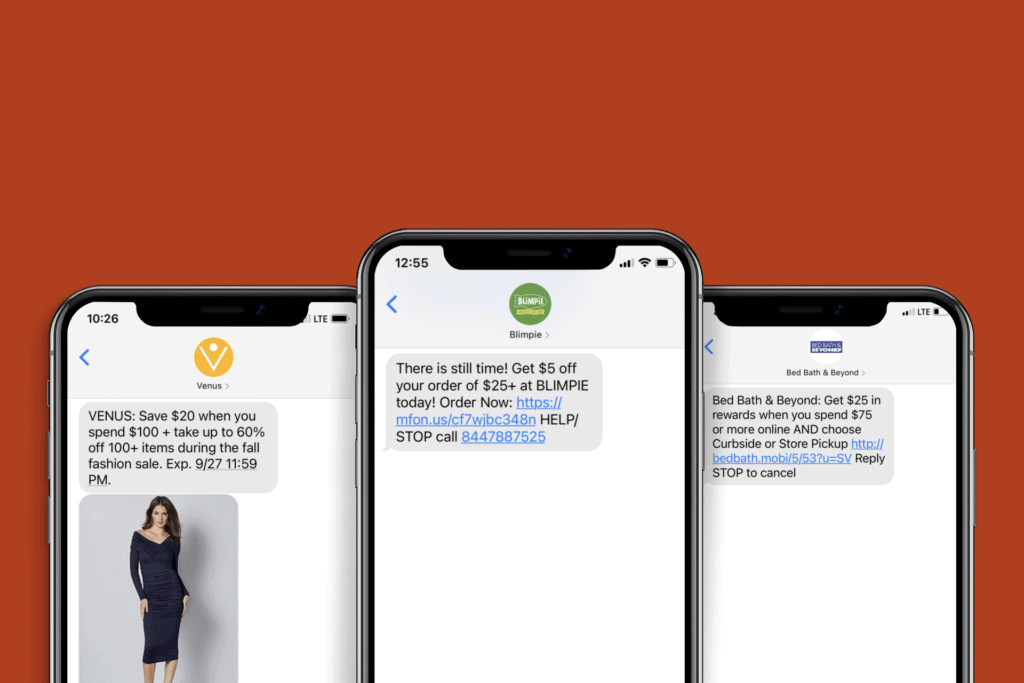
Use SMS to Reward Purchases
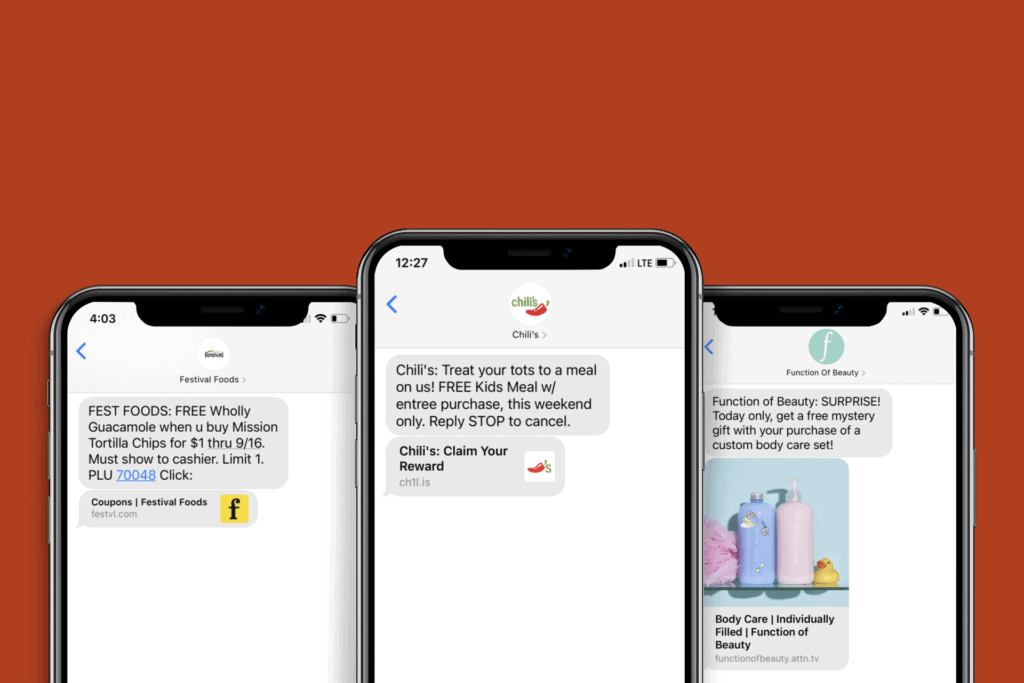
MMS Message
Multimedia Messaging Service (MMS) consists of SMS features including media content (images, GIFs, video), a subject line, and an increased character limit of 5,000 characters. Check out our MMS marketing examples below.
Use MMS to Showcase a Product Line
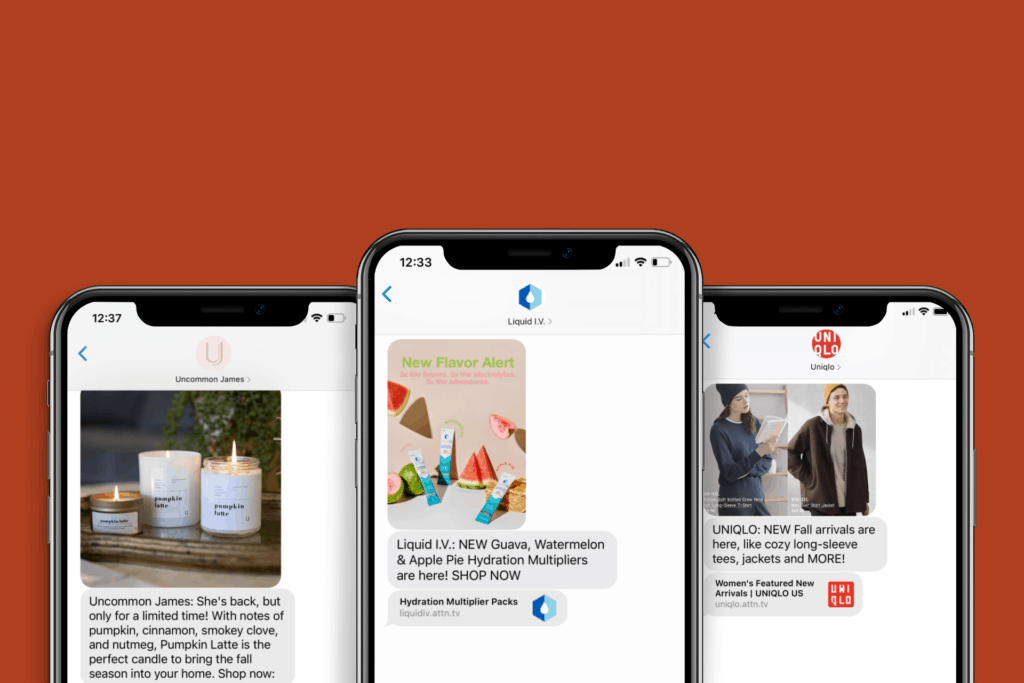
Use MMS to Promote Deals
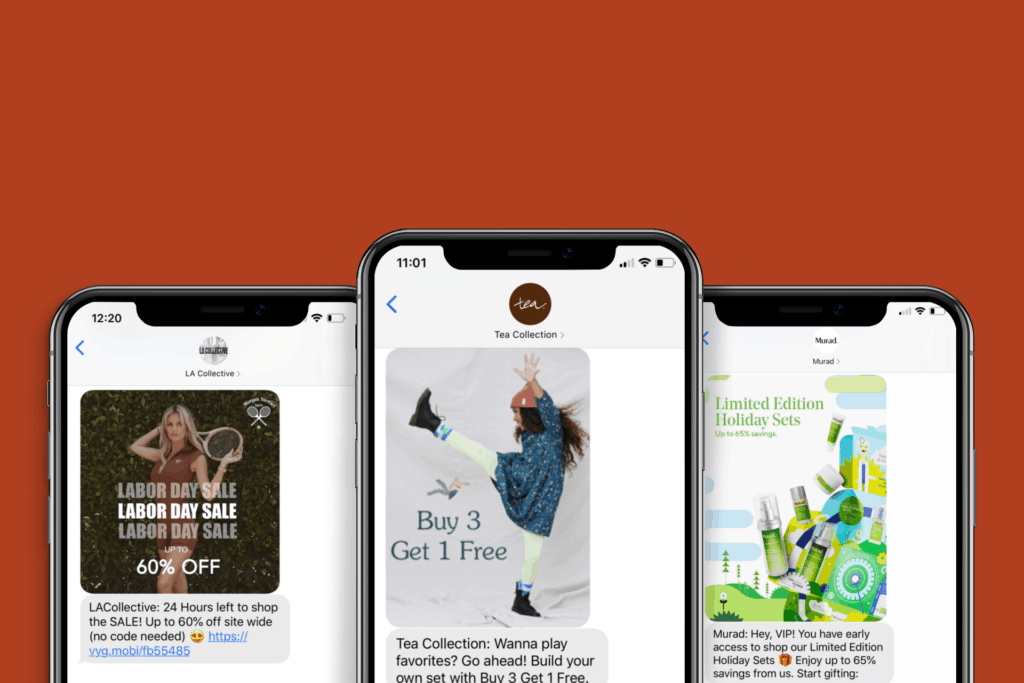
Use MMS to Visually Communicate Information
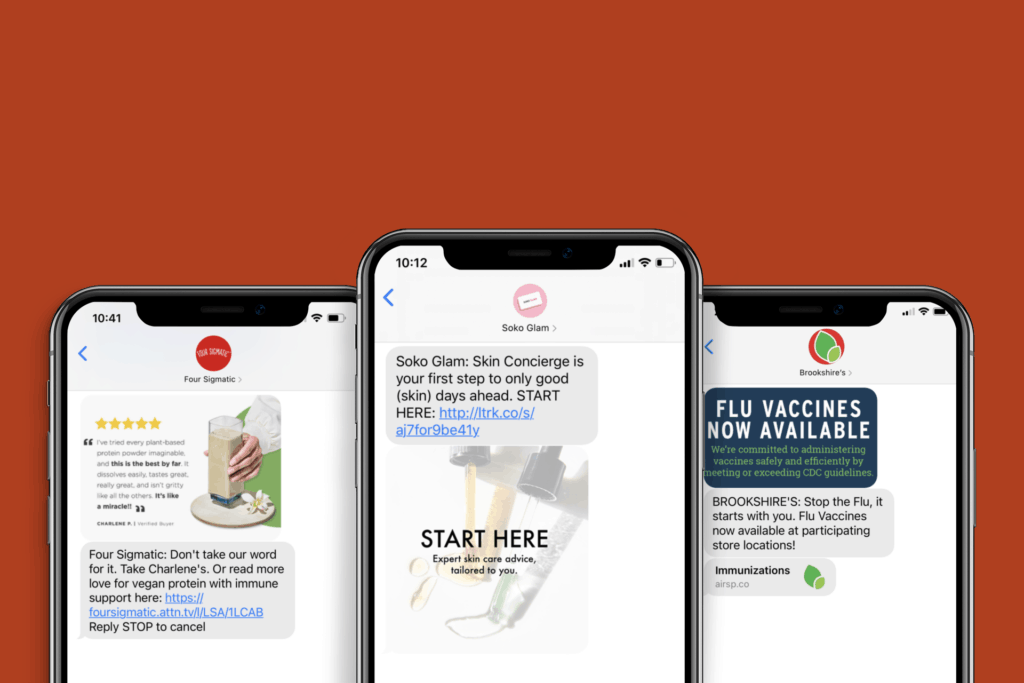
Premium SMS Short Code Partner
Did you know that Tatango is a Premium Short Code Partner? This partner designation is the highest designation given by the CTIA and the Short Code Registry and is based on specific criteria, including the number of bulk SMS short codes under management, the length of time using SMS short codes, and performance history. Although you can develop and host SMS short codes yourself, Premium Partners like Tatango specialize in software development and hosting for SMS short code applications. In addition to providing technical expertise, Premium Partners can advise for maximizing participation and SMS short code campaign results.
If you place a premium on trust, choose a Premium Partner like Tatango. For more information on getting your own short code, contact Tatango here.
Advertising Your SMS Short Code
We recommend advertising your SMS short code on popular digital marketing platforms such as online websites and social media channels like Twitter and Facebook, or through traditional advertising channels such as in-store, television, radio, or print. This builds your SMS phone numbers list faster, which results in more revenue for your business.
It’s estimated that 90% of text messages are read within three minutes of being received in a messaging app, whereas emails often sit unread long after a sale has ended. This is often the case with push notifications, also made worse by the fact that users can disable those types of notifications. The average SMS marketing click-through rate is 36%, proving that SMS marketing is an effective marketing channel.
Want to learn how best to advertise your SMS short code to customers? Download our free SMS advertising template.
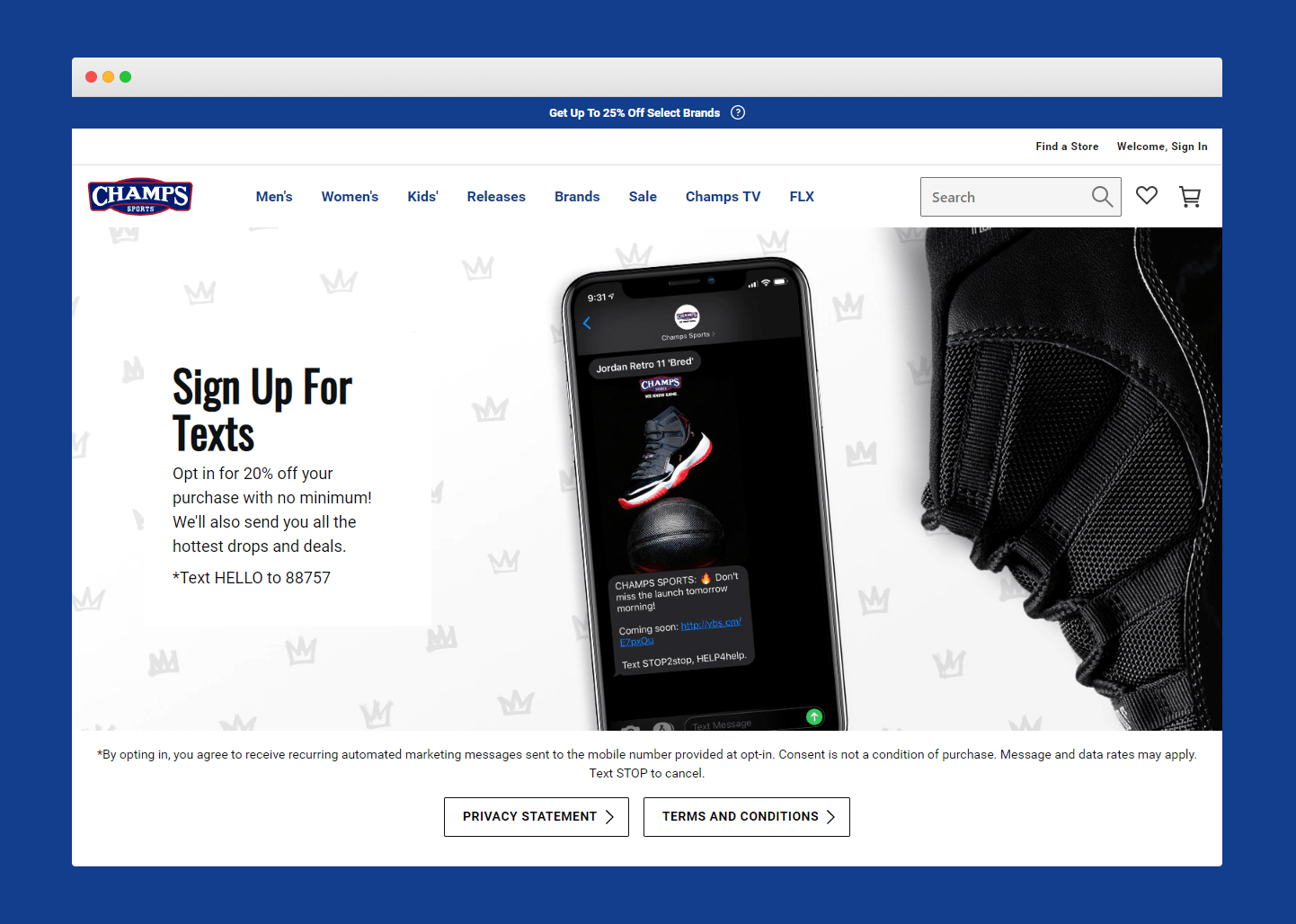
SMS Keywords
An SMS keyword is a word consumers use to join a brand’s SMS program. These SMS keywords interact with a short code that corresponds to a specific SMS campaign. SMS keywords help SMS providers like Tatango determine which SMS text messaging campaign a consumer is trying to opt into. For example, Chipotle’s SMS short code is 888-222, and the SMS keyword is “RAINCHECK.” To keep subscribers separate between different campaigns, Chipotle could use a different keyword for another campaign, like “BURRITO.” Grouping lists are useful if you want to target different lists with multiple messages.
SMS Short Codes & Long Codes – What Is the Difference?
As you just learned, an SMS short code is a 5- to 6-digit phone number specifically used for marketing purposes. Short codes are registered with the wireless carriers and have higher technical capabilities, such as a significantly faster message throughput. Thus, brands and organizations choose short codes for business text messaging and not transactional SMS messaging.
An SMS long code is a 10-digit phone number used to send and receive messages. Long code texting is typically used for transactional messages, such as delivery alerts or two-factor authentication for an app. They’re not intended for marketing purposes. Long code text message throughput is significantly slower compared to short code text message throughput. Long codes are typically inexpensive, with price starting at around $1 per phone number, whereas short code price start at around $500-$1,000 per month. There’s a difference in price and usage situations with a difference in technical capabilities as they help brands achieve different goals.
Check out the video below to learn more.
SMS Short Code Messaging Speeds
One of the reasons SMS marketers choose an SMS short code is the faster messaging speeds. SMS long-code speeds are limited by the wireless carriers at 60 SMS messages per minute, significantly slower than a short code.
Messaging speeds on SMS short codes vary by software provider. Tatango averages a whopping 98,940 messages per minute, which is 1,649 times faster than an SMS long code and 16 times faster than other SMS marketing software providers.
You may be wondering: what’s the big deal with SMS throughput speeds? Suppose an SMS marketing software provider doesn’t send text messages fast enough. In that case, subscribers could get a promotion once it’s already ended. For example, restaurants may then have their message reach consumers well after a lunch special, or political campaigns may miss out on collecting donations when the mood is high right after an important campaign rally.

Dedicated SMS Short Codes
There are several different types of SMS short codes. One type of SMS short code is called a dedicated short code, an SMS text short code used by only one business. For example, Pizza Hut has the dedicated short code 69488. Because this short code is dedicated, no other business can operate on the SMS short code 69488
When it comes to SMS marketing, most large brands such as Pizza Hut, Abercrombie & Fitch, AMC Theatres, Applebee’s, Baltimore Orioles, Bed Bath & Beyond, Bravo, and Burger King have a dedicated SMS short code. Read more information on dedicated short codes.
Why do brands want dedicated short codes?
There are many reasons why brands choose a dedicated short code, but especially for the following reasons.
- Brand Recognition: Like a brand’s web address, a dedicated short code provides complete exclusivity and recognition.
- Brand Security: Dedicated short codes allow brands to control the entire consumer experience from end to end.
- Keyword Exclusivity: With a dedicated short code, brands can use any imaginable SMS mobile keyword, allowing maximum creativity and functionality.
- Activity Control: Dedicated short codes allow brands to control how their short code is used.
- Database Portability: Customers come to know and expect your brand’s messages on a specific number. A brand needs to own that number in the case of a migration to another SMS provider.
- Scalability: Messaging speed is critical in SMS marketing. Dedicated short codes allow your brand to have direct access to wireless carriers.
Shared SMS Short Codes
Another type of SMS short code is called a shared SMS short code. A shared short code is a single short code, used and paid for by multiple brands to send short code messages.
SMS shared short codes require the use of an SMS mobile keyword. Technically speaking, each business sharing a short code is assigned a unique SMS keyword—an exclusive word dedicated only to a specific company. For example, if Paul’s Dry Cleaning and Joe’s Pizza are both using 12345 to send messages, the keyword will differentiate the campaigns. Paul’s Dry Cleaning could use the keyword “CLEAN,” and Joe’s Pizza could use the keyword “PIZZA” to enable customers to opt into the right SMS campaigns.
AT&T Bans All New Shared Short Codes
In the video below, learn what to do if you’re currently using a shared short code.
AT&T’s 1-Strike Spam Policy for Shared Short Codes
Since AT&T started banning shared short codes, they’ve taken a one-strike policy for handling SMS spam on shared short codes. To learn more about this cellular network policy and what you should be doing to protect your business, watch the video below.
Buying an SMS Short Code
Did you know that businesses don’t actually own their SMS short codes, even if they’re using a dedicated short code? SMS short codes are leased either directly to a business or an SMS provider like Tatango for a 3-, 6-, or 12-month period.
Vanity SMS Short Codes
A vanity short code consists of 5 to 6 digits chosen by a business, usually creating an easy number for consumers to recall. For example, a number like 007007 or 313131 is much easier to remember than a random number like 940217. Brands typically prefer a vanity short code because it’s easier for a consumer to remember when they see a brief advertisement on television or a billboard. Vanity short codes cost $1,000.
Non-Vanity SMS Short Codes
Non-vanity short codes are 5 to 6 digits selected at random. For example, non-vanity short codes would be numbers like 39752, 958372, or 14930. The cost of a non-vanity SMS short code is $500.
CTIA SMS Short Code Rules
To protect mobile consumers from spam text messages, the wireless carriers created a group called the Cellular Telecommunications Industry Association (CTIA) to enforce practices that are in the best interests of the consumer. To do this, the CTIA carries out audits on SMS programs based on the rules found in their CTIA Short Code Compliance Handbook. Some of these guidelines require that brands include disclosures in text messages when marketing to consumers, such as:
- “message and data rates may apply”
- “text HELP for help”
- “text STOP to unsubscribe”
If a text messaging campaign is found to be in violation of any of the guidelines in the CTIA Short Code Compliance Handbook, then the text messaging campaign can be deactivated by the wireless carriers.
TCPA SMS Short Code Rules
Before starting a mobile messaging campaign, it’s important to understand what the Telephone Consumer Protection Act (TCPA) is and how it impacts your SMS marketing campaign. The United States Congress adopted the TCPA in 1991. The Telephone Consumer Protection Act (TCPA) is a set of Federal Communications Commission (FFC) rules and regulations that govern robocalling, telemarketing, and mobile text messaging issues. The TCPA outlines requirements for brands and other organizations in the United States that use these technologies to communicate with consumers.
Brands need to know how the TCPA law applies to their communication practices and the penalties resulting from failure to comply. For example, when a brand send text alerts to consumers who have not given their consent to receive messages, the brand can end up paying fines of $500 per message. If a willful violation of the TCPA occurs, then the brand can pay as much as $1,500 per text message, per person.
The law is constantly evolving, making it difficult for brands to stay up to date on all the latest changes. To learn more about the TCPA and compliance for businesses, we recommend checking out these TCPA videos. Make sure you also download our free TCPA survival guide for more info.
SMS Short Code Registry
The Short Code Registry, along with the CTIA oversees the technical and operational aspects of the common short code functions and maintains a single database of available, reserved, and registered common short codes. To learn more about the Short Code Registry, visit usshortcodes.com

SMS Short Code Application Process
The first step in the short code application process is to select an SMS provider such as Tatango. Once you select an SMS provider, they’ll assist you in the provisioning process. As a Short Code Registry Premium Provider, Tatango has a unique advantage in our provisioning process, allowing for faster approval times.
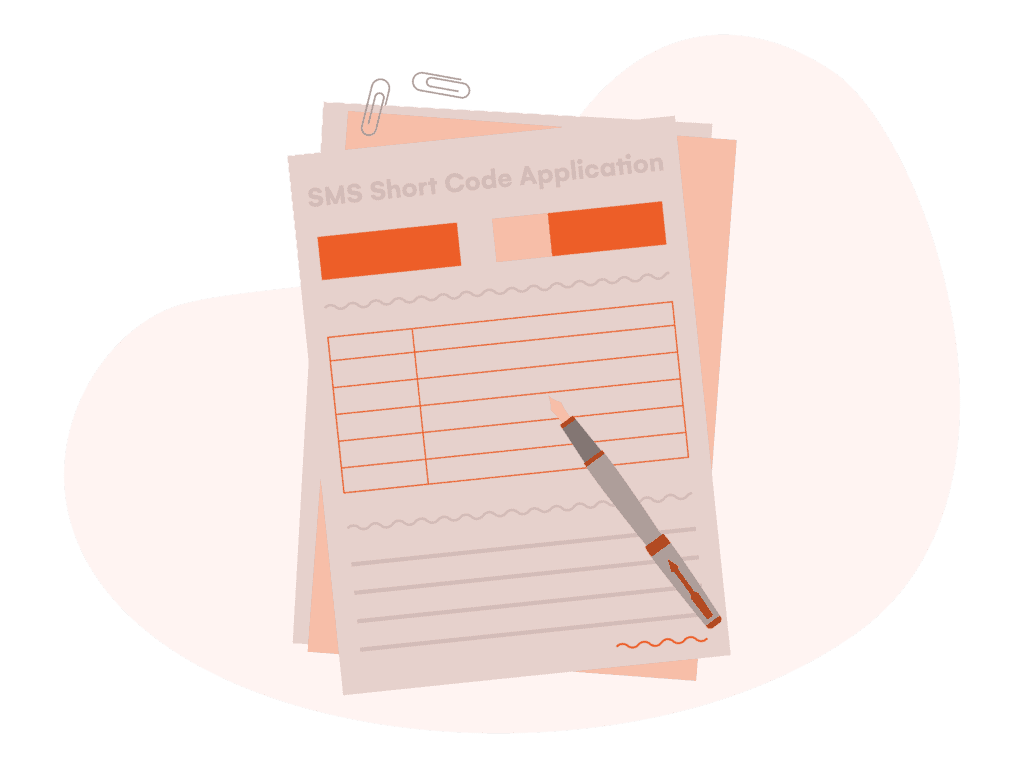
SMS Short Code Approval Timeline
In our experience at Tatango, receiving all wireless carriers’ approvals of a new dedicated SMS short code on their networks can take two to three weeks. If you’re thinking about setting up an SMS short code, it’s best to contact us immediately so we can get the process underway as quickly as possible.
SMPP Short Code Messaging
SMS short code service and messaging is sometimes referred to as Short Message Peer to Peer Protocol (SMPP) messaging. Messages sent over SMPP are routed directly to and from the wireless service provider over a secure private network. It’s the most common type of protocol messaging, and it’s the same method people use to text one another.
Canadian SMS Short Codes
Want customers in Canada to be able to opt in and receive messages from your SMS short code? You’ll need to lease a Canadian short code.
If you lease a United States short code, that short code will only be connected to US wireless carriers, so you’re only able to send and receive text messages with customers of US wireless carrier networks.
Watch the video below about international text marketing.
Premium SMS Short Codes
Premium text messaging refers to text message programs that require additional fees to subscribe for things like notification ringtones for messages app and jokes of the day. In 2013, the wireless carriers agreed that premium texting billing was confusing to consumers and as a result, premium texting is no longer in use.
How to Start Short Code Texting
Still have questions about SMS short code text messaging or SMS marketing? Contact us today, and we’ll walk you through the entire process.

